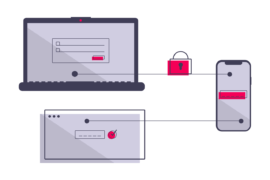Ever since Google announced that it is going to phase out third-party cookies which are already blocked by Apple’s Safari ITP and Mozilla’s Enhanced Tracking Prevention, the ad tech industry has been tirelessly looking for other possible solutions.
Also Read: How are Different Browsers Handling Web Browser Cookies?
Certainly some solutions have come into the limelight, such as Google’s Privacy Sandbox, Universal IDs, and first-party data, but the search for other concrete solutions is still on.
The major problems with third-party cookies are their invasive nature and a lack of transparency concerning their use-case. Unarguably, these are also the reasons for the emergence of privacy laws like GDPR and CPRA. So, the need of the hour is to ensure that publishers or advertisers are handling user data with the utmost sense of responsibility.
If the user is privy to knowledge about how their data is being used, they can also be enticed to share valuable and relevant information themselves. This is how zero-party data can come into play in the ad tech industry.
In this blog, we are going to throw light on zero-party data, its importance in the ad tech industry, how it is different from first-party data, and how publishers can scale it.
What is Zero-Party Data and Why is it Significant?
Forrester Research came up with the term ‘zero-party data’ for data that a user shares “intentionally and proactively” with brands. Also known as explicit data, zero-party information is the key to gathering user data that is almost incontestable.
If we think about it, nothing can be more important than valid user data at the present time. Personalization is gaining traction rapidly in the programmatic advertising ecosystem, and zero-party data can do wonders in this regard. Publishers and advertisers can see how users actually want to engage with them and hence, can cater to their content needs in a much better way. Clearly, publishers can effectively monetize their websites in a much better way by leveraging zero-party knowledge.
The most important thing to note about zero-party data is that issues related to user consent are eliminated. Because the user is sharing their data knowingly, publishers or advertisers won’t face any privacy related problems. Basically, the whole process of targeting users by using their personal information becomes highly transparent and non-invasive by leveraging zero-party data.
Difference between Zero-Party and First-Party Data
The differences between zero-party data and third-party and second-party data are quite obvious, since latter are obtained from outside sources. But, it may become slightly difficult to differentiate zero-party and first-party data. The following table soughts to clear confusion about the same:
| Zero-Party Data | First-Party Data |
| Data that the user shares intentionally | Data that is collected on the basis of user behaviour when they visit a website |
| Highly accurate and relevant | More accurate and relevant than third-party and second-party data |
| Can be collected via surveys, quizzes, contests, social media stories etc. | Can be collected via registration forms |
| No privacy concerns, given the user is aware why the data is being collected | Minimal concerns regarding privacy invasion |
How can Publishers Leverage Zero-Party Knowledge?
User engagement is easily one of the most important factors when it comes to effectively monetizing websites. If the user is not actually inclined to engage with the content and ads, it’s basically all wasted effort. In order for this to happen, publishers need to provide users with highly personalized content without invading their privacy. Zero-party data can be leveraged to offer exactly such services to users.
For publishers to actually scale zero-party data, they will have to first figure out ways to collect it. This can be done by creating online surveys, providing consumers with recommendations based on their interest, and quality content that is appealing to users. Using social media channels, download history, and different types of game-based solutions, such as contests or quizzes, can also be of help.
Offering users good interactive experience can perhaps be the best way to collect accurate zero-party data. Basically, publishers need to put the user at the center and then create content that will entice them to share information.
Once you have managed to collect relevant and accurate data from the user, you will need to segment users on the basis of their information. This will allow you to target a large group of audience in an efficient manner. Publishers can seek help from data management platforms for segmenting their audiences.
Another thing that publishers can do is to use zero-party data and first-party data together. This will allow them to create user profiles that are highly accurate and relevant. Building user personas in such a way will be much more structured and effective.
Some Factors to Consider
Publishers might have understood that zero-party knowledge can become an asset for them in the post-cookie world. But even when you are using zero-party data, make sure to take into consideration the following points:
- Be transparent about why you are collecting the data and how you are going to use it. The whole point why cookies are being phased out is the lack of transparency regarding their use. So, publishers should be vary of shady activities that may jeopardize user privacy.
- Another thing that is important is allowing users to change their data as and when required. This will not only be beneficial for the user but for publishers as well, since they will have the latest and the most accurate data this way.
Final Thoughts
It cannot be said that zero-party data is the perfect replacement for third-party data, mostly because publishers cannot get the ideal volume of data that is needed for marketing strategies this way, but it certainly can be used in addition to other solutions.
An amalgamation of different alternatives, such as first-party and zero-party data and universal ID solutions may prove to be yielding for publishers in the post-cookie world.

Shubham is a digital marketer with rich experience working in the advertisement technology industry. He has vast experience in the programmatic industry, driving business strategy and scaling functions including but not limited to growth and marketing, Operations, process optimization, and Sales.







